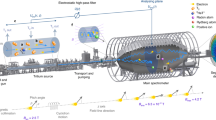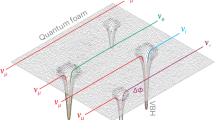Abstract
The chargeless, weakly interacting neutrinos are ideal astronomical messengers as they travel through space without scattering, absorption or deflection. But this weak interaction also makes them notoriously difficult to detect, leading to neutrino observatories requiring large-scale detectors. A few years ago, the IceCube experiment discovered neutrinos originating beyond the Sun with energies bracketed by those of the highest energy gamma rays and cosmic rays. I discuss how these high-energy neutrinos can be detected and what they can tell us about the origins of cosmic rays and about dark matter.
This is a preview of subscription content, access via your institution
Access options
Subscribe to this journal
Receive 12 print issues and online access
$209.00 per year
only $17.42 per issue
Buy this article
- Purchase on Springer Link
- Instant access to full article PDF
Prices may be subject to local taxes which are calculated during checkout





 and W+W− annihilation.
and W+W− annihilation.
Similar content being viewed by others
References
Greisen, K. Cosmic ray showers. Annu. Rev. Nucl. Part. Sci. 10, 63–108 (1960).
Reines, F. Neutrino interactions. Annu. Rev. Nucl. Part. Sci. 10, 1–26 (1960).
Markov, M. On high energy neutrino physics. Proc. 10th Intl Conf. High-Energy Physics, Rochester, New York, 578–581 (1960).
Reines, F. & Cowan, C. L. The neutrino. Nature 178, 446–449 (1956).
Berezinsky, V. & Zatsepin, G. Cosmic rays at ultrahigh-energies (neutrino?). Phys. Lett. B28, 423–424 (1969).
Roberts, A. The birth of high-energy neutrino astronomy: a personal history of the DUMAND project. Rev. Mod. Phys. 64, 259–312 (1992).
Gaisser, T. K., Halzen, F. & Stanev, T. Particle astrophysics with high-energy neutrinos. Phys. Rep. 258, 173–236 (1995).
Learned, J. & Mannheim, K. High-energy neutrino astrophysics. Annu. Rev. Nucl. Part. Sci. 50, 679–749 (2000).
Halzen, F. & Hooper, D. High-energy neutrino astronomy: the cosmic ray connection. Rep. Prog. Phys. 65, 1025–1078 (2002).
Becker, J. K. Status of neutrino astronomy. J. Phys. Conf. Ser. 136, 022055 (2008).
Baade, W. & Zwicky, F. Cosmic rays from super-novae. Proc. Natl Acad. Sci. USA 20, 259–263 (1934).
Waxman, E. Cosmological gamma-ray bursts and the highest energy cosmic rays. Phys. Rev. Lett. 75, 386–389 (1995).
Sullivan, G. Results from the IceCube experiment. Nucl. Phys. Proc. Suppl. 235-236, 346–351 (2013).
Ahrens, J. et al. Muon track reconstruction and data selection techniques in AMANDA. Nucl. Instrum. Methods A524, 169–194 (2004).
Aartsen, M. et al. Energy reconstruction methods in the IceCube neutrino telescope. JINST 9, P03009 (2014).
Kopper, C., Giang, W. & Kurahashi, N. Observation of astrophysical neutrinos in four years of IceCube data. PoS ICRC2015, 1081 (2015).
Schoenen, S. & Rädel, L. A measurement of the diffuse astrophysical muon neutrino flux using multiple years of IceCube data. PoS ICRC2015, 1079 (2015).
Aartsen, M. G. et al. Evidence for astrophysical muon neutrinos from the northern sky with IceCube. Phys. Rev. Lett. 115, 081102 (2015).
Weaver, C. Spring APS Meeting (APS, 2014).
Aartsen, M. et al. First observation of PeV-energy neutrinos with IceCube. Phys. Rev. Lett. 111, 021103 (2013).
Schönert, S., Gaisser, T. K., Resconi, E. & Schulz, O. Vetoing atmospheric neutrinos in a high energy neutrino telescope. Phys. Rev. D79, 043009 (2009).
Gaisser, T. K., Jero, K., Karle, A. & van Santen, J. A generalized self-veto probability for atmospheric neutrinos. Phys. Rev. D90, 023009 (2014).
Aartsen, M. et al. Observation of high-energy astrophysical neutrinos in three years of IceCube data. Phys. Rev. Lett. 113, 101101 (2014).
Ahlers, M. & Halzen, F. Pinpointing extragalactic neutrino sources in light of recent IceCube observations. Phys. Rev. D90, 043005 (2014).
Aartsen, M. et al. Flavor ratio of astrophysical neutrinos above 35 TeV in IceCube. Phys. Rev. Lett. 114, 171102 (2015).
Aartsen, M. et al. Atmospheric and astrophysical neutrinos above 1 TeV interacting in IceCube. Phys. Rev. D91, 022001 (2014).
Ackermann, M. et al. The spectrum of isotropic diffuse gamma-ray emission between 100 MeV and 820 GeV. Astrophys. J. 799, 86 (2015).
Glüsenkamp, T. Analysis of the cumulative neutrino flux from Fermi-LAT blazar populations using 3 years of IceCube data. Preprint at https://arXiv.org/abs/1502.03104 (2015).
Padovani, P. & Resconi, E. Are both BL Lacs and pulsar wind nebulae the astrophysical counterparts of IceCube neutrino events? Mon. Not. R. Astron. Soc. 443, 474–484 (2014).
Padovani, P., Resconi, E., Giommi, P., Arsioli, B. & Chang, Y. L. Extreme blazars as counterparts of IceCube astrophysical neutrinos. Mon. Not. R. Astron. Soc. 457, 3582–3592 (2016).
Krauß, F. et al. TANAMI blazars in the IceCube PeV neutrino fields. Astron. Astrophys. 566, L7 (2014).
Kadler, M. et al. Coincidence of a high-fluence blazar outburst with a PeV-energy neutrino event. Preprint at https://arXiv.org/abs/1602.02012 (2016).
Feldstein, B., Kusenko, A., Matsumoto, S. & Yanagida, T. T. Neutrinos at IceCube from heavy decaying dark matter. Phys. Rev. D88, 015004 (2013).
Esmaili, A. & Serpico, P. D. Are IceCube neutrinos unveiling PeV-scale decaying dark matter? JCAP 1311, 054 (2013).
Bai, Y., Lu, R. & Salvado, J. Geometric compatibility of IceCube TeV-PeV neutrino excess and its galactic dark matter origin. JHEP 1601, 161 (2016).
Bhattacharya, A., Reno, M. H. & Sarcevic, I. Reconciling neutrino flux from heavy dark matter decay and recent events at IceCube. JHEP 1406, 110 (2014).
Esmaili, A., Kang, S. K. & Serpico, P. D. IceCube events and decaying dark matter: hints and constraints. JCAP 1412, 054 (2014).
Cherry, J. F., Friedland, A. & Shoemaker, I. M. Neutrino portal dark matter: from dwarf galaxies to IceCube. JCAP 12, 054 (2014).
Murase, K., Laha, R., Ando, S. & Ahlers, M. Testing the dark matter scenario for PeV neutrinos observed in IceCube. Phys. Rev. Lett. 115, 071301 (2015).
Esmaili, A. & Serpico, P. D. Gamma-ray bounds from EAS detectors and heavy decaying dark matter constraints. JCAP 10, 014 (2015).
Aartsen, M. et al. Search for dark matter annihilations in the Sun with the 79-string IceCube detector. Phys. Rev. Lett. 110, 131302 (2013).
Abbasi, R. et al. Search for dark matter from the galactic halo with the IceCube neutrino observatory. Phys. Rev. D84, 022004 (2011).
Abbasi, R. et al. Search for neutrinos from annihilating dark matter in the direction of the galactic center with the 40-string IceCube neutrino observatory. Preprint at https://arxiv.org/abs/1210.3557 (2012).
Aartsen, M. et al. IceCube search for dark matter annihilation in nearby galaxies and galaxy clusters. Phys. Rev. D88, 122001 (2013).
Rameez, M., Monaruli, T. & Vallecorsa, S. (for the IceCube Collaboration) Search for dark matter annihilations in the Sun using the completed IceCube neutrino telescope number. PoS ICRC2015, 1209 (2015).
Zoll, M. (for the IceCube Collaboration) Improved methods for solar dark matter searches with the IceCube neutrino telescope number. PoS ICRC2015, 1099 (2015).
Gondolo, P. et al. DarkSUSY: computing supersymmetric dark matter properties numerically. JCAP 0407, 008 (2004).
Ullio, P., Kamionkowski, M. & Vogel, P. Spin dependent WIMPs in DAMA? JHEP 07, 044 (2001).
Aartsen, M. et al. IceCube-Gen2: a vision for the future of neutrino astronomy in Antarctica. Preprint at https://arXiv.org/abs/1412.5106 (2014).
Zheleznykh, I. Early years of high-energy neutrino physics in cosmic rays and neutrino astronomy (1957–1962). Intl J. Mod. Phys. 21, 1–11 (2006).
Markov, M. & Zheleznykh, I. On high energy neutrino physics in cosmic rays. Nucl. Phys. 27, 385–394 (1961).
Babson, J. et al. Cosmic ray muons in the deep ocean. Phys. Rev. D42, 3613–3620 (1990).
Balkanov, V. et al. The BAIKAL neutrino project: status report. Nucl. Phys. Proc. Suppl. 118, 363–370 (2003).
Aggouras, G. et al. A measurement of the cosmic-ray muon flux with a module of the NESTOR neutrino telescope. Astropart. Phys. 23, 377–392 (2005).
Aguilar, J. et al. First results of the Instrumentation Line for the deep-sea ANTARES neutrino telescope. Astropart. Phys. 26, 314–324 (2006).
Migneco, E. Progress and latest results from Baikal, Nestor, NEMO and KM3NeT. J. Phys. Conf. Ser. 136, 022048 (2008).
Margiotta, A. Status of the KM3NeT project. JINST 9, C04020 (2014).
Ahrens, J. et al. Sensitivity of the IceCube detector to astrophysical sources of high energy muon neutrinos. Astropart. Phys. 20, 507–532 (2004).
Halzen, F. & Klein, S. R. IceCube: an instrument for neutrino astronomy. Rev. Sci. Instrum. 81, 081101 (2010).
Halzen, F. Neutrino astronomy: an update. Riv. Nuovo Cimento 36, 81–104 (2013).
Aartsen, M. et al. Search for neutrino-induced particle showers with IceCube-40. Phys. Rev. D89, 102001 (2014).
Murase, K., Ahlers, M. & Lacki, B. C. Testing the hadronuclear origin of PeV neutrinos observed with IceCube. Phys. Rev. D88, 121301 (2013).
Choi, K. et al. Search for neutrinos from annihilation of captured low-mass dark matter particles in the Sun by Super-Kamiokande. Phys. Rev. Lett. 114, 141301 (2015).
Tönnis, C. et al. Overview of dark matter searches with ANTARES number. PoS ICRC2015, 1207 (2015).
Avrorin, A. D. et al. Search for neutrino emission from relic dark matter in the Sun with the Baikal NT200 detector. Astropart. Phys. 62, 12–20 (2014).
Boliev, M. M., Demidov, S. V., Mikheyev, S. P. & Suvorova, O. V. Search for muon signal from dark matter annihilations in the Sun with the Baksan Underground Scintillator Telescope for 24.12 years. JCAP 1309, 019 (2013).
Amole, C. et al. Dark matter search results from the PICO-2L C3F8 bubble chamber. Phys. Rev. Lett. 114, 231302 (2015).
Savage, C., Gelmini, G., Gondolo, P. & Freese, K. Compatibility of DAMA/LIBRA dark matter detection with other searches. JCAP 0904, 010 (2009).
Aalseth, C. E. et al. Search for an annual modulation in a p-type point contact germanium dark matter detector. Phys. Rev. Lett. 107, 141301 (2011).
Agnese, R. et al. Silicon detector dark matter results from the final exposure of CDMS II. Phys. Rev Lett. 111, 251301 (2013).
Acknowledgements
Discussion with collaborators inside and outside the IceCube Collaboration, too many to be listed, have greatly shaped this presentation. Thanks. This research was supported in part by the US National Science Foundation under Grant Nos ANT-0937462 and PHY-1306958 and by the University of Wisconsin Research Committee with funds granted by the Wisconsin Alumni Research Foundation.
Author information
Authors and Affiliations
Corresponding author
Ethics declarations
Competing interests
The author declares no competing financial interests.
Rights and permissions
About this article
Cite this article
Halzen, F. High-energy neutrino astrophysics. Nature Phys 13, 232–238 (2017). https://doi.org/10.1038/nphys3816
Received:
Accepted:
Published:
Issue Date:
DOI: https://doi.org/10.1038/nphys3816
This article is cited by
-
Multi-messenger astrophysics
Nature Reviews Physics (2019)
-
Ten years of AGILE: the mission and scientific highlights
Rendiconti Lincei. Scienze Fisiche e Naturali (2019)
-
Observation of AGILE transient \(\gamma \)-ray sources in coincidence with cosmic neutrino events
Rendiconti Lincei. Scienze Fisiche e Naturali (2019)
-
Linking high-energy cosmic particles by black-hole jets embedded in large-scale structures
Nature Physics (2018)



